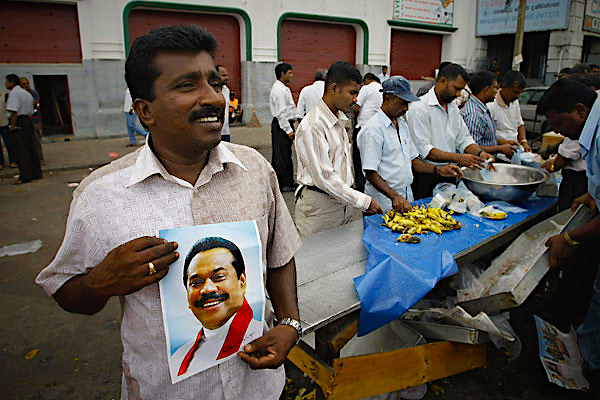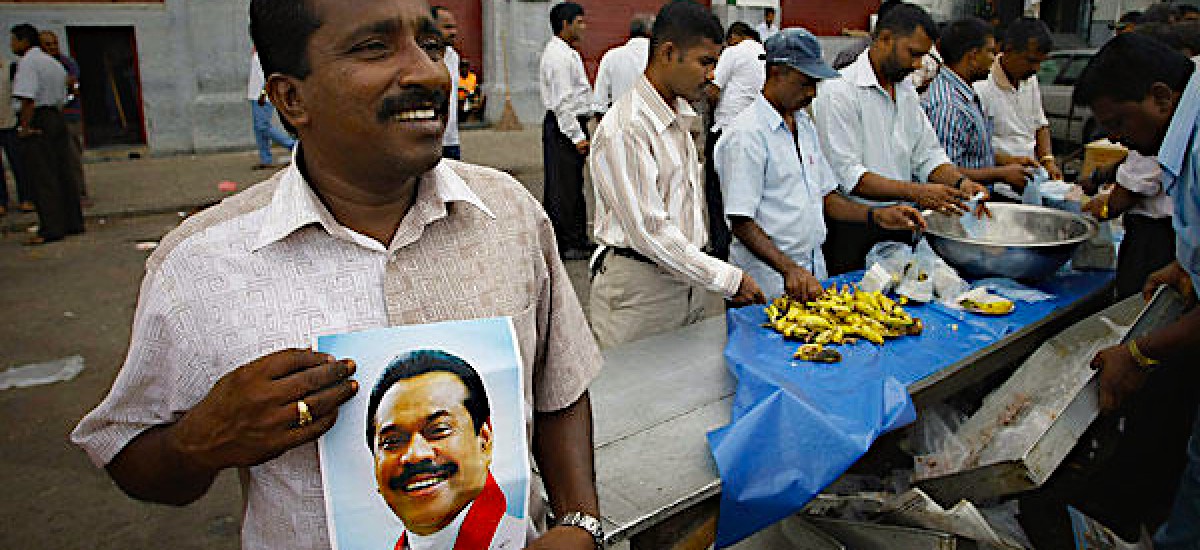
Photo credit: Eranga Jayawardena / AP, taken from Christian Science Monitor
In his most famous and controversial work, Prof Samuel Huntington listed Sri Lanka’s armed conflict as an example of his key category of ‘fault line wars’. The war is over but the fault lines perhaps remain. Are the fault lines staying static, widening, narrowing, or in a dialectical sense, both widening and narrowing? Is it still too early to tell?
Ours is an uneven peace, but it is not unusual, two years after a war, especially a decades-long one. The crucial questions are whether things are better than in wartime or worse, and whether the rate of improvement is on par with the global and historical average or far below.
The answers require a comparative and evolutionary perspective.
- Compare the post-conflict phase with wartime and remember that no lethal violence on any significant scale is taking place now.
- Compare the fascist LTTE’s control of the North then with that of the Sri Lankan armed forces now and decide which is better from the vantage point of the whole country as well as that of parents of the area whose children are not being forcefully conscripted anymore and citizens who aren’t being illegally taxed as then.
- Compare the gradual economic, administrative, informational, international and social connectivity and osmosis of prosperity today, with the isolation and malign neglect of the wartime decades.
What then of the phenomenon described as militarisation, and the corresponding call for de-militarisation?
Here too an evolutionary and comparative-historical approach is imperative. The prolonged hosting of a brutal hostile militia and the extension of a degree of social support to them, especially in a civil war context, does not usually result in sweetness and light on the morning after. Following the US Civil war against secession, the victorious Union (i.e. Northern) armies remained in the South for twelve years and withdrew only as a result of an electoral deal.
Even under the most liberal administrations, security considerations sometimes result in policy practices that focus on certain sociological categories and geographic areas in a manner that could be perceived as discriminatory. A recent issue of International Herald Tribune carried photographs and a story of US troops obtaining biometric data (‘eyeball printing’) of an enormous number of men of ‘fighting age’ in Afghanistan.
The call for the de-militarization of the North must be seen in the correct, gradualistic perspective. The North is strategically vital for the security of the island. It has been the passage for invasions from across the waters over millennia. As such there can be no question of the withdrawal of the Sri Lankan military or even its downsizing and redeployment on anything other than strictly military criteria. There obviously has to be a permanent and adequate military presence in the North. What can be legitimately debated and subjected to change is the military ‘footprint’ in everyday social and civilian life. Currently this seems a function of the weakness of the machinery of civil administration in the area, and the resultant vacuum. That needs to be addressed; filled.
The critics ask why President Rajapaksa, who has a historic military victory and a two-thirds majority in Parliament, does not swiftly solve the problem by striking a deal with the TNA. Matters are not quite as unproblematic as they seem. The TNA rejects or at best (and more recently) is utterly ambivalent about the existing Constitutional provisions for devolution. This leaves the Sinhala majority quizzical about the ceiling of TNA aspirations: what would be the ‘final status’ agreement? Where is the firebreak between autonomy and creeping secessionism? The suspicions of the Sinhalese and the security establishment are fuelled by memories of Chief Minister Vardarajaperumal’s abortive putschism of 1989-90, the far more recent memories of the TNA’s role and rhetoric as fellow-traveller of the Tigers, the inflammation of anti-Lankan sentiment in Tamil Nadu, the TNA’s refusal to make any criticism whatsoever of the Tigers and their war, that party’s intemperate charges against the armed forces (“tens of thousands of Tamil civilians killed by deep penetration units”) in the course of its prolonged applause of the Darusman Report, and the increasing overlap between the more strident elements of the Tamil émigrés and the TNA.
In sum, President Rajapaksa is hardly blessed with a moderate, pragmatic peace partner. Therefore, in a highly partisan, competitive democracy, he has to exercise political prudence, while avoiding political paralysis.
Whatever the problems and rough edges of the ongoing election campaign in the North, what is more important is that the TNA is among the legal choices open to the voters. In liberal Spain, NATO and EU member, a corresponding party, Herri Batasuna, the parliamentary representative of Basque nationalism, has been proscribed as having links with violent separatism, namely the ETA.
Is this grim realism unrelieved by any prospect of opening and reform? Hardly. There are three reform projects either running or in the offing: the LLRC report, the ongoing dialogue between the Government and the TNA and the proposed Parliamentary Select Committee.
The criticism that the Select Committee idea is dilatory ignores the reported suggestion by President Rajapaksa that it be strictly time bound and limited to three to six months. Why not build that into the terms of the committee?
There is more than a little hypocrisy involved in the Opposition’s political responses. The TNA has called the Select Committee a waste of time. However, these potential peace partners had wasted time over the years, by refusing to accept the existing Constitutional arrangements on devolution even as a starting point for discussion, backing out at the last minute of signing potential agreements (with the Muslim Congress) negotiated by President, Premadasa, rejecting the Mangala Moonesinghe Select Committee Report, and GL Peiris/Sirisena Cooray compromise proposal of linkage through an Apex Council.
Having thus wasted no less than 20 years indulging in the rhetoric of rejectionism, the TNA is oblivious to the irony of currently complaining that the proposed a PSC would be a waste of time.
As for the UNP General Secretary Mr Tissa Attanayake who makes a similar complaint of a prospective waste of time, he has doubtless forgotten—the burning by the UNP in parliament, of President Kumaratunga’s draft Constitution of August 2000 ( a draft which was strongly argued for on the floor of the House by Messrs Kadirgamar and Ashraff).
The jaded cynicism which greets the reform initiatives and ideas also overlooks two other factors. Firstly, the GoSL-TNA dialogue, if successful, requires a safety net of broad consensus and anchorage in the legislature –which should therefore not feel by-passed, reduced to a mere rubber stamp. Secondly, the PSC provides the drawing together of the UPFA and UNP in a moderate consensus which would permit a healthy enhancement of public consciousness and render the reforms far less susceptible to radical or extremist nationalism.
Sri Lanka’s critics expect a ‘big bang’ of post-war improvement. This is the same advice they urged on post-socialist Russia, which under Yeltsin, paid a heavy price for going along with this Western wisdom 20 years ago. It took President Putin’s strongly statist leadership and Sergei Lavrov’s stewardship of foreign policy for Russia to recover from that adventurist experiment.
An accurate appreciation of post-war Sri Lankan prospects for peace-building requires a gradualist, evolutionary perspective in which the reform openings (LLRC, talks with the TNA, the PSC) are not seen as isolated initiatives. When taken together, they are capable of cumulatively catalysing constructive change.

